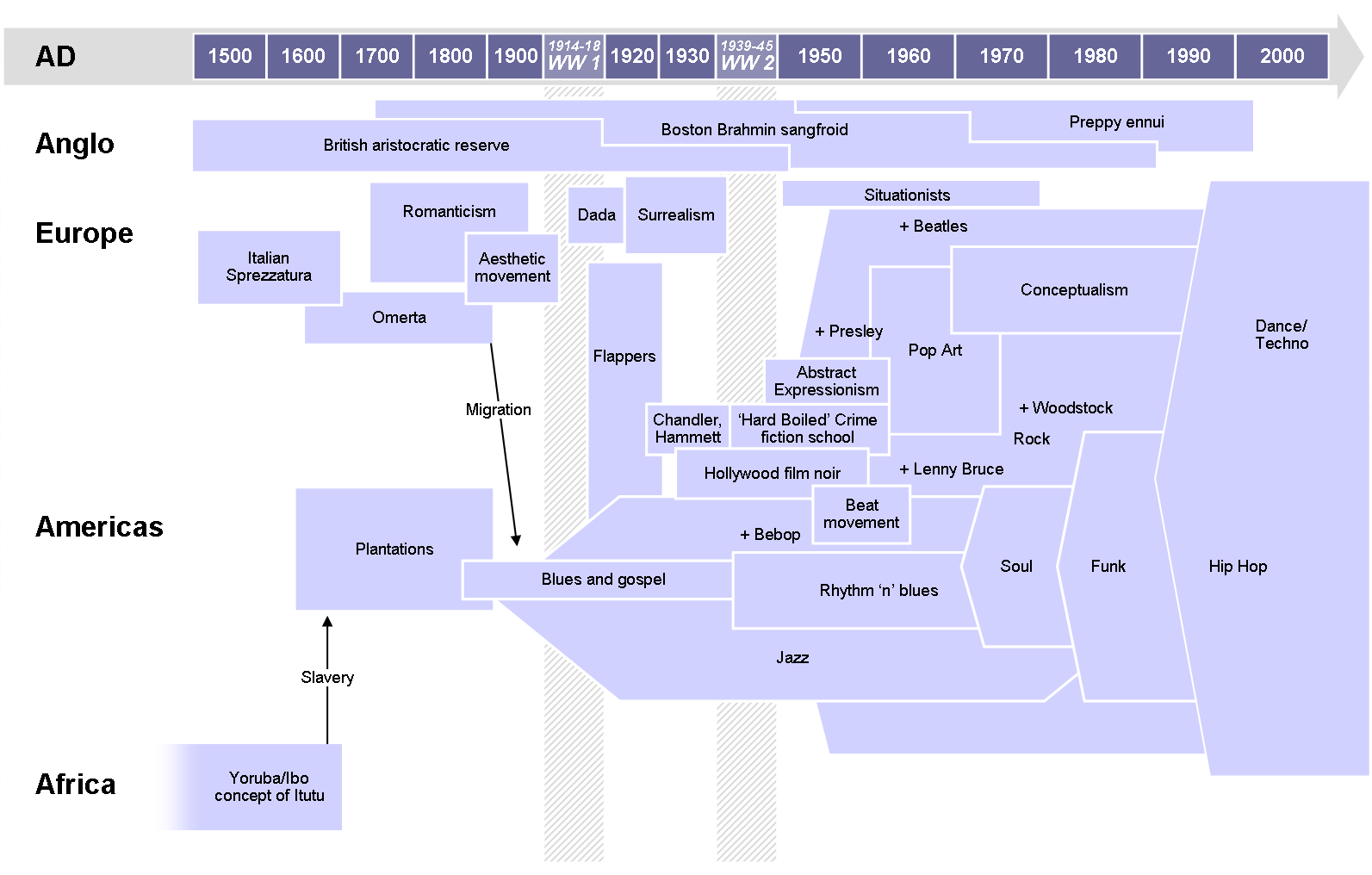Forbes released its list of America's coolest cities. Houston won. Houston also owns the crown of America's fattest city. Ranks as one of the most overpriced cities. And it is consistently recognized as having America's worst sprawl. Oh, Google "Houston aesthetic." You get a list of cosmetic surgeons, and not a particularly riveting Houston city look or scene.
So, what gives?
Nothing. It all fits, really. You see, American "cool" has been trending from a point of distinction into a sea of non-descriptiveness for some time. You know: Miles Davis meets Kim Kardashian, and the birth of cool mopes into the death of cool. And we only have ourselves to thank for it.
Exhibit A. See the chart below courtesy of Wikipedia. It is a timeline of cool. In it, the collaborators work under the assumption that "cool" is counter-culturally driven, with cool's creative powers and pose contrasting against the status and state of the era's establishment. In the early 1900's you see Dadaism and Surrealism -- the Marcel Duchamp's of the world -- bumping up against Robert Johnson's blues and gospel crew in the American south. And then from there the ecology of cool really takes off, splitting into film noir, jazz, bepop, the Beats, pop art, the Beatles, and Lenny Bruce...

Then what happens? Well, in the 90's you see a collapsing of the differentiation that made the "cool" of the mid-century so contextually rich. Many would argue it was due to the co-opting of counterculture into main, money-making culture, with the complete capitalization of cool eventually giving way to a blob consisting of techno and hip hop, with even these two genres sacrificing their hardscrabble roots to form the lovechild epitomized by the recent TV episode in which Kim Kardashian makes Lamar Odom sit in a dentist chair for 7 hours because of his bad breath.
That's our cool now. Not exactly Miles Davis blowing his horn to shreds in the din of New York's Studio 61, circa 1959. It's kind of emptying when you think about it.
Of course this lineage of killing cultural cool can also be found in the devolution of cool places. Increasingly absent are the peculiarities and intricacies of cities. These things are swallowed by demand, higher rents, as the mechanics of strictly cash tend to push the weird and fun shit out. In fact New York's bordering-on-insane success in terms of cashing in on space is a real and literal threat to the consumption of its once-rugged, only-in-New York essence. Take this recent article from the Times called, tellingly, "Who You Calling Gritty?" It begins: "HIPNESS is contagious in Brooklyn, where expanding the global brand seems to be a done deal."
And goes on:
Vinyl siding doesn't represent Greenpoint's cachet any longer; virtual doormen, rooftop farms, artisanal gin and brick-faced condominiums do. The virtual gatekeeper is a prime amenity at the sold-out 93-unit Pencil Factory condominium on West Street, where the penthouse sold for just over $1 million, a neighborhood first.
And won't stop:
No more bargain $8 haircuts, not even for dogs, though the local canines may have noticed the revamped sidewalks feel a tad smoother beneath their paws: gentrification is smoothing out all those hard edges.
Bah. What we see here is New York, America's 10th coolest city, being driven by the same larger forces that have come to define the plasticity of cities represented by Houston. More broadly, cool's baton has passed from the righteous middle finger to the consuming grin, with its aesthetic increasingly massaged by some kind of homogenous boardroom mentality that has consistently been cleaning up our culture and sterilizing our grit.
Hell, it's gotten so bad that even the Presbyterians are blogging about it. Speaking about the recent book Gentrification of the Mind: Witness to a Lost Imagination by Sarah Schulman, a young pastor in Georgia writes:
Schulman argues that broad cultural, economic, and behavioral changes have moved urban society toward residential homogeneity and also residential segregation. This homogeneity in our lived environments...squelches genuine creativity, social mixing, and democratic flourishing.
Schulman reinforces the concept by saying that the whole culture of suburbanization that emerged in the 50s created a different kind of person..."who was willing to trade freedom for security." Schulman calls this mindset "a supremacy ideology," a standardized vision of taste and culture reinforced by the economic means to enforce one's tastes on others.
Of course we can also just explain Houston being the coolest by saying Forbes is full of shit. While there is some validity to that, I would argue that, no, Houston is modern America's coolest city. "Cool," after all, is what you make of it. Time to face the facts, amigos. Or the reality that we are all but a collective version of Lamar Odom sitting in a comforting kind of shame as the cool goddess of Kardashian stands over us, wagging her finger, and demanding our sterilization.
